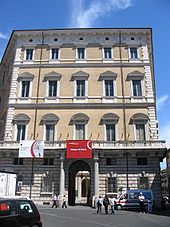- Palazzo Braschi
-
Palazzo Braschi is a large Neoclassical palace in Rome, Italy and is located between the Piazza Navona, the Campo de' Fiori, the Corso Vittorio Emanuele II and the Piazza di Pasquino. It presently houses the Museo di Roma, the civic museum of Rome.
It was built by the papal nephew Duke Luigi Braschi Onesti,[1] to designs by Cosimo Morelli. The site was purchased in 1790 by Braschi, supported by funds from Pope Pius VI;[2] Braschi demolished the 16th-century palace that Giuliano da Sangallo the Younger had built for Francesco Orsini in order to erect his own from the ground up.[3] Construction was suspended in February 1798 during the Napoleonic occupation of the city, when the French temporarily took possession of it until 1802 and confiscated the recently-acquired collection of antiquities it contained (though Braschi was reimbursed for them). In 1809, when Rome was declared an Imperial city by Napoleon, Duke Luigi moved into the palace and was declared mayor.
On his death in 1816 the palace remained unfinished and the family funds depleted. In 1871 the Braschi Onesti heirs sold the building to the Italian State. During the Italian fascist period, it was used as the political headquarters of Benito Mussolini. After the war, it housed 300 refugee families and many of the interior frescoes were seriously damaged by the fires they lit to keep warm. In 1949 the palace passed to the civic authorities and, following extensive conservation in 1952, the present installation of the museum was effected, .
The main entrance is on Via San Pantaleo (between Piazza Navona and Corso Vittorio Emanuele). The oval hall inside the main entrance overlooks Via San Pantaleo, and leads to the monumental staircase with its eighteen red granite columns which came from the gallery built by the Emperor Caligula on the banks of the River Tiber. Decorating the staircase there are ancient sculptures and fine stuccoes by Luigi Acquisti inspired by the myth of Achilles.
The architect Giuseppe Valadier designed the chapel on the piano nobile or first floor.
Notes
- ^ He was the son of Count Girolamo Onesti and Giulia Braschi, sister of Pope Pius VI, who created him Duke of Nemi.
- ^ The cultural politics of Pius VI are discussed in Jeffrey L. Collins, Papacy and Politics in Eighteenth-Century Rome: Pius VI and the Arts (Cambridge) 2006; ch. 5 details the erection of obelisks and the building of the Palazzo Braschi for his family.
- ^ Palazzo Braschi
External links
Coordinates: 41°53′50.8″N 12°28′22.3″E / 41.897444°N 12.472861°E
Categories:- Palaces in Rome
- Art museums and galleries in Rome
- 19th-century architecture
- Neoclassical palaces
- Neoclassical architecture in Italy
- European museum stubs
- Italian building and structure stubs
Wikimedia Foundation. 2010.

